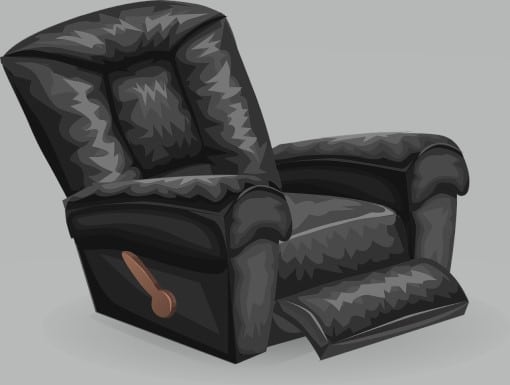
Sleeping upright with sleep apnea – What we know and 3 things to try
By Jason Wooden, PhD
It’s no surprise people are wondering about sleeping upright with sleep apnea since symptoms are worse for many patients if they lay on their back.
Recent research suggests that elevating your head may indeed help improve symptoms.
Depending on your sleep apnea type, symptom severity, and other factors, you have options – simple tricks to elevate your head and new devices designed to keep you from sleeping on your back.
CONTENTS:
A) Why sleep upright with sleep apnea?
B) Can your sleep position affect sleep apnea?
C) Any evidence sleeping upright with sleep apnea can help?
D) 3 ways to sleep upright with sleep apnea
E) Any downsides from sleeping upright with sleep apnea?
F) How else can I change my sleep position?
A) Why sleep upright with sleep apnea?
You’re probably not the first to wonder about sleeping upright with sleep apnea.
They’re currently 18 million sleep apnea sufferers in the US alone, all too many waking up exhausted day after day.
It’s a miserable experience, so it’s no surprise people are desperate to figure out everything they can do to sleep better.
Personally, I’ve only tried sleeping upright in a recliner a few times without much success. Luckily, CPAP seems to be working out for me.
I know this is not the case for everyone. Even with a variety of CPAP setups, many people still find CPAP uncomfortable and give up within the first year.
Out of curiosity, I did a quick survey of five sleep apnea sufferers I know. Only one had ever tried sleeping upright and told me it didn’t help.
But this is all anecdotal, so let’s take a more serious look at whether this simple trick can really help the millions of sleep apnea sufferers.
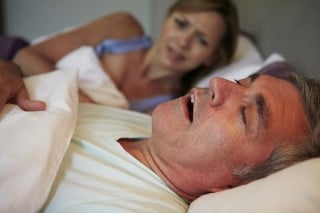
B) Can your sleep position affect your sleep apnea?
Okay, this is where we need to talk about the two main types of sleep apnea, obstructive and central.
Obstructive sleep apnea (OSA) is a mechanical problem. It happens when muscles in the throat relax during sleep causing the airway to collapse and interrupt breathing.
Central sleep apnea is a communication problem. It happens when the brain fails to send the right signals to the muscles that control breathing.
Most people suffer from OSA and this is who this article is focused on.
It’s long been known that sleeping on your back can make sleep apnea worse, presumably because the tongue relaxes back towards the throat leading to even more obstruction.
Did you know that over half of OSA sufferers are “position-dependent”? Their symptoms are worse if they sleep on their back.
One of the treatments for them is positional therapy, an approach which encourages people to sleep more on their sides so that the throat is less obstructed and they get more restful sleep.
In studies, it has been shown to reduce symptoms using special sleep-positioning pillows or vibration alarms attached to the neck or chest. Patients stay on their side more, have fewer breathing disruptions, and sleep better.
So, while there isn’t any direct evidence that something as simple as sleeping upright in a chair can help, there’s a lot of research that says your sleep position matters.
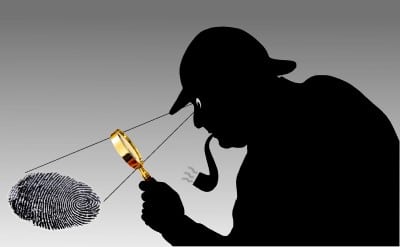
C) Any evidence sleeping upright with sleep apnea can help?
Can sleeping upright in a chair really help sleep apnea?
And what about sleeping upright in a bed?
This strategy hasn’t been as well studied as side sleeping, but there is research that suggests that elevating your head can help reduce OSA symptoms.
In the 80s, researchers did a small clinical study with 13 male sleep apnea patients. In half the patients, symptoms went away if they slept at a 60-degree angle.
These turned out to be people who were more obese.
More recently, Brazilian researchers did a bigger clinical study with 52 middle-age and overweight patients. Unlike the earlier study, they included both males and females.
They had them sleep in a bed designed to partially elevate their head at a comfortable angle (7.5-degrees instead of 60-degrees which is pretty steep and uncomfortable for prolonged sleeping times!).
They found that this simple setup was able to reduce the severity of sleep apnea by 30 percent and worked best for people with mild to moderate OSA.
So, while no one has done a chair sleep apnea study, there’s good evidence that elevating your head may help improve your sleep.
D) Three ways to sleep upright with sleep apnea
Before you try this strategy, you should check with a doctor to see if it makes sense for your sleep apnea type.
You should also keep in mind that the research suggests head elevation will be most useful if:
- you’re overweight
- severity of your OSA symptoms are mild to moderate
- you slightly elevate your head
And it may be useful for situations when you are unable to sleep on your side, the traditional way of treating position-dependent sleep apnea.
Nonetheless, here are some tricks to elevate your head:
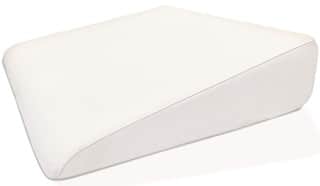
Pillows
You can try doubling up a couple pillows, but you may find a foam wedge pillow more comfortable and effective since they’re designed to elevate the head with good body alignment.
With lots of options available online, this affordable option is worth a try.
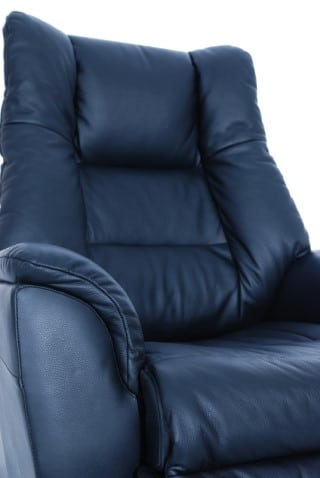
Recliner
Sleeping in a chair hasn’t been directly tested for sleep apnea, but if you have a recliner it’s certainly worth a try.
If you have to buy one, look for a recliner with good body support for any other health issues you may such as back or neck pain.
You should also make sure it reclines enough so that your head is only partially elevated.
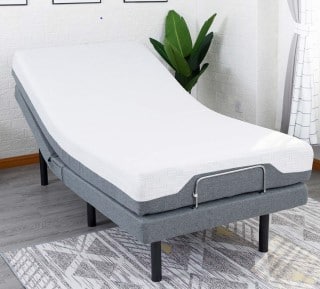
Adjustable bed
While more expensive than the other options, there are lots of adjustable beds available online in a wide price range.
Again, be sure to look for a setup with a mattress that gives good body support and allows you to slightly elevate your head.
E) Any downsides if you sleep upright with sleep apnea?
Like anything else, there are tradeoffs if you sleep upright.
While some animals are able to sleep standing upright, the human body appears to be adapted to sleep best while laying down.
Some of the potential downsides from sleeping upright include:
- You may not be as comfortable as you would be in a bed
- You may not sleep as deeply as you would if you were laying down
- Body aches and pains
- Increased risk for deep-vein thrombosis, a blood clot in a limb that can occur if your arms or legs are bent and you are motionless for a long time. (You can learn more about this here.)
So, depending on your situation, sleeping upright might be best used as a short-term remedy.
F) How else can I change my sleep position?
Don’t limit yourself to sleeping upright in bed or on a chair.
Check with your doctor to see if other sleep positioning strategies might work better for you.
Have you given side sleeping a fair try?
A number of sleep aides have been designed to encourage the body to sleep on its side, ranging from simple low setups to high tech devices:
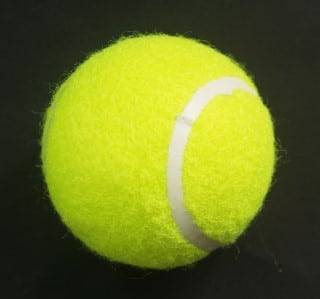
Tennis ball
As low tech as it gets, it involves sewing a tennis ball into the back of a t-shirt. If you move onto your back during sleep, the pressure will wake you and get you to move back to your side.
It’s been shown in clinical studies to be a good short-term remedy and may be worth a try if you’re strapped for cash. Learn more
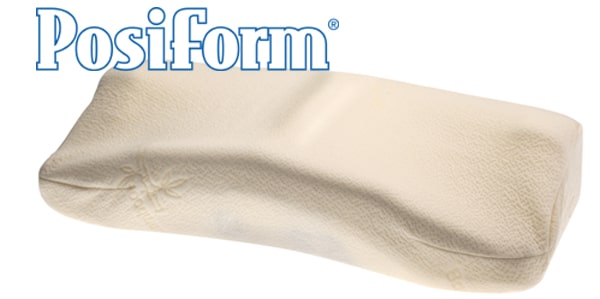
Sleep positioning pillow
If you look online, you’ll find special pillows designed to encourage side sleeping and help with snoring. Some may also help with sleep apnea.
One example is the PosiForm® pillow which has been shown in a clinical study to improve sleep apnea symptoms.
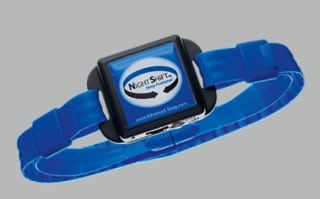
Wearable devices with vibrator
Among the latest sleep apnea devices, they’re designed to “train” your body to sleep more on your side. Strapped to the chest or the back of the neck, they detect when you sleep on your back and vibrate to urge to you to switch to your side.
While more expensive than a tennis ball or pillow, NightShift and NightBalance have been shown in studies to be effective.
What to remember about sleeping upright with sleep apnea:
- Symptoms are worse for many sleep people when on their back
- Depending on your situation, elevating your head may help
- Research suggests slight elevation is best
- There are simple tricks you can try
- Check with a doctor to see if this makes sense for you
Sources:
1. “Sleep Apnea”, National sleep Foundation website.
2. Trends in CPAP adherence over twenty years of data collection: a flattened curve, J Otolaryngology Head Neck Surg. 2016, 45: 43.
3. Positional therapy in the management of positional obstructive sleep apnea-a review of the current literature, Sleep Breath. 2018, 22(2):297-304.
4. Can positional therapy be simple, effective and well tolerated all together? A prospective study on treatment response and compliance in positional sleep apnea with a positioning pillow, Sleep Breath. 2018, 22(4):1143-1151.
5. Efficacy of the New Generation of Devices for Positional Therapy for Patients With Positional Obstructive Sleep Apnea: A Systematic Review of the Literature and Meta-Analysis, J Clin Sleep Med. 2017, 13(6):813-824.
6. The effects of posture on obstructive sleep apnea, Am Rev Respir Dis. 1986, 133(4):662-6.
7. The influence of head-of-bed elevation in patients with obstructive sleep apnea, Sleep Breath. 2017, 21(4): 815–820.
8. Efficacy of the “tennis ball technique” in patients with positional obstructive sleep apnoea syndrome, European Respiratory Journal 2011, 38: p2217.
9. Efficacy of the New Generation of Devices for Positional Therapy for Patients With Positional Obstructive Sleep Apnea: A Systematic Review of the Literature and Meta-Analysis, J Clin Sleep Med. 2017, 13(6): 813–824.
Connect with us:
About Us
Better Sleep Simplified® was founded as a place for you to get clear and well-researched information.
Our goal is to make sure you know about your options so that you take action sooner rather than later.
Check us out on YouTube:
Watch and Learn
Helpful sleep tips, interesting sleep facts and statistics you want to know about
Affiliate Disclosure
This site is a participant in the Amazon Services LLC Associates Program and other affiliate advertising programs designed to provide a means for sites to earn advertising fees by advertising and linking to them.
Important: BetterSleepSimplified.com is for informational purposes only and is not intended or implied to be a substitute for professional medical advice, diagnosis, or treatment. Always consult a physician for sleep and health concerns. See additional information.
